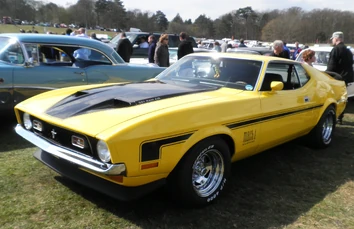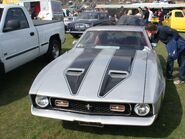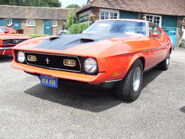
Ford Mustang Mach 1
The Ford Mustang Mach 1 was a performance model of the Ford Mustang that Ford first produced in 1969. That production run of the Mach 1 ended in 1979, when Ford phased the Mustang II coupe out in favor of newer Mustangs on the Fox body platform.
The Mach 1 returned in 2003 as a high performance version of the Mustang. Ford discontinued the Mach 1 again after the 2004 model year, when it replaced the SN-95 platform with the S197 for the 2005 model year.
Ford first used the name "Mach 1" in its 1959 display of a concept "Levacar" in the Ford Rotunda. This concept "vehicle" used a cushion of air as propulsion on a circular dais. This concept car was orange and white.
Introduction of the Mach 1[]
The Ford Mustang was introduced in 1964 as a sporty "pony car" to attract younger buyers into Ford products. After only a few short years of development, Ford saw the need to create performance Mustangs to compete with GM and their release of the Chevrolet Camaro and Pontiac Firebird. While several performance options had existed in the form of factory 289's (from the '65s on) & factory FE engines (new for 1967 with the S-Code Engine), the vast majority of Ford Mustang's performance mantle was carried by cars modified by the legendary Carroll Shelby. 1969 was the benchmark year for Ford Mustang in its proliferation of performance names and engines. No less than 7 factory performance Mustang models were available (Boss 302, Boss 429, Shelby GT350, GT500 and the Mach 1). Additionally, nine variations of V-8s were available in the '69–'70 cars. The GT model was discontinued after 1969.(1969 GT sales had dropped to 4,973 vs 72,458 1969 Mach 1's sold.) The "GT" Mustang would not be around again until 1982 on the Fox body platform.
Ford never offered the Mach 1 as a convertible (although the 1973 model apparently offered a Mach 1 convertible version, as shown in the photographs later in this article). It was a fastback only model. The new Mustang chassis, the last of the 1st generation models, allowed for larger engines than previous generations and could fit even the monstrous 429 for Ford's planned homologation of the engine for NASCAR competition. For Ford, the Mach 1 was introduced as an in-between model, a fit between the lower priced GT and the track oriented Boss 302s and 429s. The Mach 1 started with the fastback "Sports Roof" body and added several visual and performance enhancing items such as matte black hood with hood pins, chrome gas cap and wheels, chrome exhaust tips (except 351W 2V), and dealer optional chin and rear deck spoilers, and louvers. Standard equipment was a 351W 2V Windsor motor with a 3 speed manual transmission, and a 9" 28 spline open rear axle. A 351W 4V was optional as was a 390 4V, and the huge 428 4V Cobra Jet or with the "drag pack" option, the 428 4V Super Cobra Jet. A 4 speed manual or 3 speed FMX (small block)/C6 (big block) automatic transmission was optional, and the 428SCJ added a cast iron tailshaft in place of the regular aluminum one to the C6. A "traction lok" rear axle was optional, and the 428 CJ/SCJ included a "traction lok" with a 3.91 or 4.30 ratio, 31 spline axle shafts and a nodular case. In 1970, the 3.91 ratio was a "traction-lok", while the 4:30 ratio was a Detroit locker.
Mach 1s came with upgraded suspension to varying degrees dependent upon powertrain choices. Big block cars had front shock tower reinforcement, thicker sway bars (no rear bar for 69), and heavier springs and shocks. 428 CJ/SCJ 4 speed cars also came with staggered rear shocks. Standard on Mach 1s was a fierce but cosmetic hood scoop that had integrated turn-signal lights mounted in the back. A more functional option was the signature "Shaker hood", an air scoop mounted directly to the top of the motor, used to collect fresh air and so named for its tendency to "shake" above the rumbling V-8 below. The interior came complete with teak wood grain details, full sound deadening material and high-back sport bucket seats. The name Mach 1 could not have been more appropriate as in 1969, Performance Buyer's Digest put a new Mach 1 through its paces at Bonneville, breaking some 295 USAC speed and endurance records. Ford kept the Mach 1 alive into 1970 and little changed outside the visual. New Mach 1 specific bucket seats, Magnum 500 wheels, recessed taillights on a black honeycomb rear panel as well as new side and rear badging and striping were the main visual differences. Outselling the base GT model, Ford canceled the GT altogether to make the Mach 1 the primary street performance Mustang.
Production changes[]
With Ford's withdrawal from Trans-Am officially following 1970, the high end Boss 302 and 429 disappeared and were replaced by the large street-oriented Boss 351. The 1971 Mustang was larger in almost every dimension. In 1971 the Mach 1 started with a base engine of the 302ci based Windsor motor, with a 2 barrel carburetor. The lineup of engines included four 351 Cleveland engines: The 2-V, 4-V, the C.J.(Cobra Jet) and H.O.(BOSS 351). The H.O was canceled after mid-year 1971, and shortly thereafter the low-compression 351 'Cobra Jet' became available. The lineup topped out with two 429ci options, the CJ (Cobra Jet) & SCJ (Super Cobra Jet). Mach 1s, as well as all other Mustang models (except the BOSS 351) were optionally available with the CJ and SCJ motors. The SCJ came with a drag pack V or W code rear gears, oil cooler and a different rotating assembly. 429 Super Cobra Jet engines used a Holley 4-barrel carburetor, while the Cobra Jet engines made do with a GM-sourced Rochester Quadra-Jet 4-barrel carburetor.
The early version of 1971 Mustang Mach 1 (without side stripe decals) was featured in the James Bond film, Diamonds Are Forever (1971), 1973 Mach 1 named Eleanor was driven in Gone in 60 Seconds (1974).
In 1972, the 429CJ & SCJ's were dropped from the lineup, and horsepower dropped across the board. The following year also produced the fewest Mach 1 sales of the 1971-73 generation. There are no major differences in the '71 and '72 Mustangs externally, other than different script on the trunk panel. The only difference externally on the '72 Mach 1 was the deletion of the 71-only pop-open gas cap on the Mach 1 for the standard Mustang twist-on gas cap for '72 Mach 1s. Apparently, the pop-open gas caps were prone to spilling fuel in a rear end collision, so Ford discontinued their use across the board. The 302 was still the base engine, with 2 barrel or 4 barrel 351 Clevelands being the only options in the Mach 1 lineup.
In 1973, the Front end was changed to fit new bumper standards, and a new Mach 1 grille was made. The Mach 1 grille in prior years had 2 "sportlamps" horizontally across the grill on the left and right side, while the functional parking lamps rode low underneath the front bumper at the outer ends of the valance panel. In 1973, all Mustang models had the sportlamps changed to a vertical orientation at each end of the grill, and these lamps served double duty as the parking lamps also. This was necessary since the new-for-73 front bumper was larger and effectively blocked the view underneath the bumper, the previous location of the parking lamps.
The rear bumper was also mounted on new bump-absorbing extensions which caused the bumper to protrude from the body about an inch farther than before. The Mach 1 graphics were also updated to a simpler, yet bolder design, which was necessitated by the change in the front bumper. Engine options remained the same as in 1972. One of the most recognizable as well as popular features of the '71-'73 block-off plates in the scoops, so it was a visual, non-functional item. However, they could be made fully functional on models ordered with the 'ram-air' option. This included vacuum controlled 'flappers' at each scoop, and a huge fiberglass underhood 'plenum' that directed cool, outside air into the carburator for increased performance. The ram-air option included a two-tone hood paint treatment in either 'matte black' or 'argent' (matte silver), coordinated to the color of the Mach 1 decals and striping. In addition, all ram-air equipped Mustangs of this generation came equipped with big twist-style chrome-plated hood lock pins.
Because of the popularity of the ram-air option, but because of the trouble getting the ram-air option approved for emissions reasons, Ford offered an 'exterior decor' option in 1973 that consisted of the two-tone paint treatment and the hood pins, but without the actual functional components of the 'ram air' system. The only engine that the functional 'ram-air' option was available on in 1973 was the 351 2-V, even though the 351 4-V 'Cobra Jet' was optional on every model.
Mustang II - Mach 1 package[]
The Mach 1 was the performance package, fitted with the 2.8 L V6 rated at 105 hp (78 kW). The 1974 Mach 1s outsold the previous four years with the V6 in the light for its size 2,700 lb (1,200 kg) II. Next year the 302 was brought back into the Mustang, giving a much needed performance boost. At 140 hp (100 kW) and 240 lbf·ft (325 N·m) of torque, the MII was available with a 4-speed manual. It formed the top end of performance in the Mustang IIs. With 1976 came the introduction of another "performance" model, the Cobra II. In 1977 little changed but the grille of the Mustang and 1977 proved to be the lowest selling year of the Mach 1 yet, selling only 6,719 cars. It is also worth noting that four of the five years of the Mustang II are on the top-ten list of most-sold Mustangs ever. Nothing changed for 1978 other than Ford adding yet another performance model to the lineup, the King Cobra. This became the final year for the Mustang II as well as their performance models. The Mach 1 name was discontinued.










